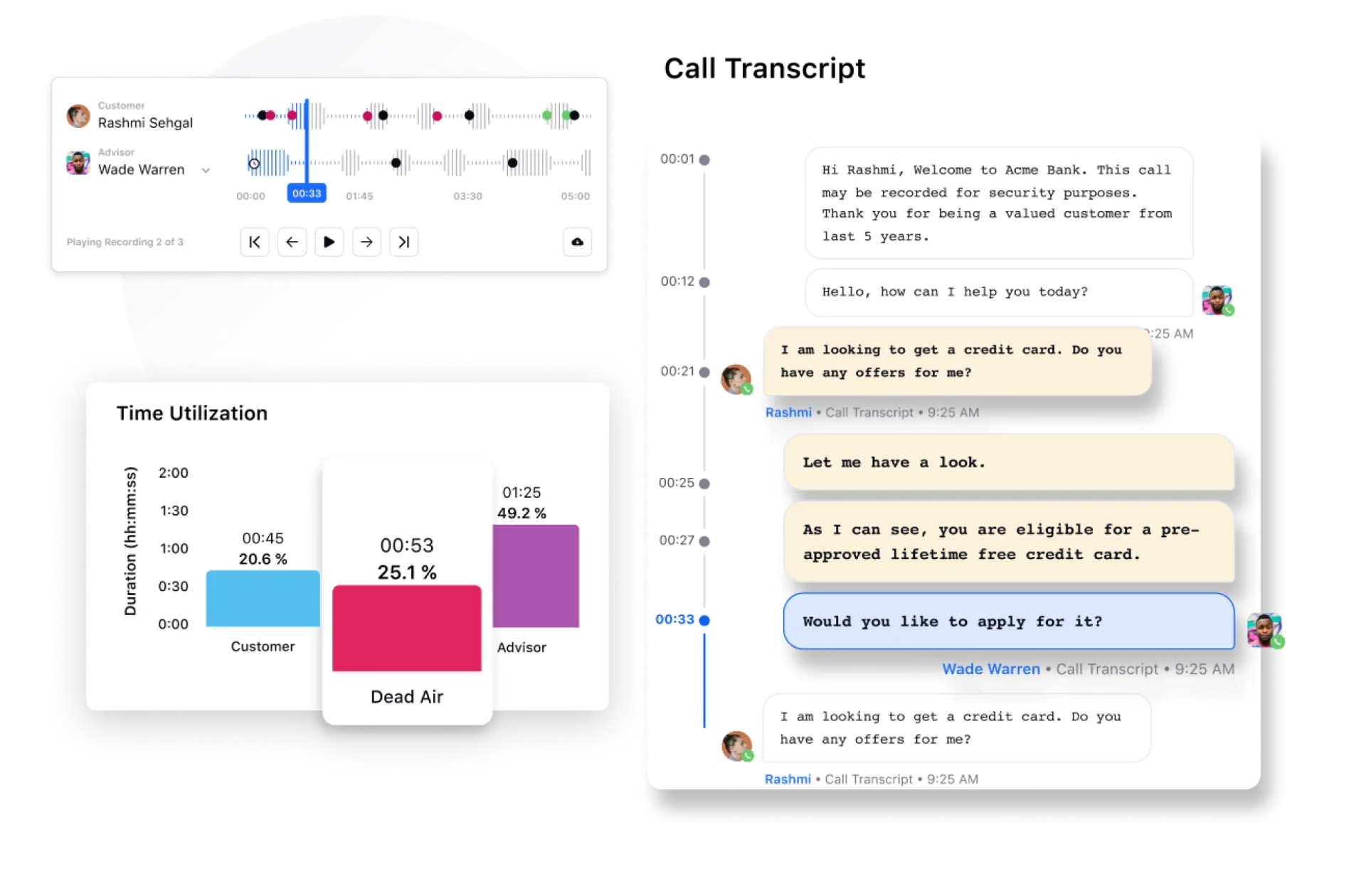Great customer experiences are a result of happy employees.
And today, there’s really no shortcut around it: Companies must stay mindful of the engagement levels of their support teams. Engaged and motivated support agents can drive support quality and customer satisfaction in a big way. Over time, companies have realized the power and potential of workforce optimization (WFO) or Workforce engagement (WEM) as Gartner likes to term it.
It’s not surprising to see agents churn when they don’t find their jobs engaging, motivating and rewarding. In fact, majority of millennial and Gen Z agents choose to leave companies that don’t invest in training and development.
It’s nothing unachievable — focus on optimizing your contact center workforce and it will make sure to not leave a single customer unhappy or behind.
But what is contact center workforce optimization anyway?
Contact center workforce optimization or WFO is the process of efficiently managing and maximizing the performance of contact center agents. It's a systematic approach that ensures they perform their very finest, at each customer interaction.
In this blog, we'll explore contact center workforce optimization, its key aspects and its transformative impact. Whether you're a contact center supervisor or a business owner, this guide will provide insights and strategies to revolutionize your customer support quality and performance.
Benefits of workforce optimization in contact center

The heart of your business beats within the contact center, where agents hold the power to delight, influence and shape customer perceptions. WFO takes a radical approach beyond simply “managing” your workforce. It looks at making the talent holistically efficient so that the end-user experiences augment. Here are some transformative benefits of workforce optimization in contact centers:
1. Amplify your agent productivity
By combining intelligent call routing, streamlined workflows, automation and comprehensive customer service training programs, WFO boost contact center agent productivity and engagement. Empowered with the right skills and knowledge, agents excel in their roles.
2. Elevate customer experiences
With modern customers switching channels rapidly and continuously, there’s a need to deliver a seamless digital customer experience across all touchpoints and workforce optimization delivers just that. By integrating multiple communication channels, from phone and email to live chat and social media, your agents effortlessly switch between platforms, maintaining context and continuity, creating a unified customer experience journey that leaves a lasting impression.
3. Reduce your costs
By optimizing staffing levels, streamlining processes and fine-tuning resource allocation, you'll witness a meteoric rise in cost efficiency. Optimizing your workforce also helps you stay compliant to labour laws and subsequently prevent risk and the costs associated with non-compliance.
4. Boost business growth
Beyond customer satisfaction, contact center workforce optimization fuels business growth. Exceptional service drives repeat purchases, referrals and positive reviews, turbocharging your revenue engine. Contact centers that analyze past interactions and bank on Voice of customer (VOC) can detect points of improvement and opportunities to upsell/cross-sell.
5. Improve operational agility
Contact center workforce optimization enhances your ability to adapt to changing business needs and customer demands. By implementing flexible scheduling, skill-based routing and dynamic resource allocation, you can quickly adjust to fluctuating call volumes, optimize agent utilization and maintain service excellence even during peak periods.
How does WFO work in contact center?
Optimizing your workforce in contact center would typically consist of three broad steps:
Workforce management (WFM)
Workforce Management (WFM) is used to establish an equilibrium between the workforce and workload. It encompasses forecasting, scheduling and performance measurement (plus reporting).
Forecasting
You start by forecasting the staff requirements, both in terms of quantity and expertise. Contact center forecasting involves analyzing seasonal demands, historical and projected trends and business rules to arrive at precise predictions.
Scheduling
Next, you construct task queues and staff schedules, factoring in intraday fluctuations like unplanned leaves.
You can take into account a multitude of variables, including case severity, employee availability, workload and individual preferences. Effective call scheduling ensures there’s enough staff to handle forecasted case volumes.Measuring and reporting performance
Last, you need to track how well your agents are performing to manage them better. Track your agents’ performance against your set service level agreements and metrics like average handling time, first contact resolution, etc.
Important note: Piling up tickets on agents with no logic will only lead to chaos. Forecasting and scheduling your agents can be aided by intelligent contact center routing solutions that use varied logics to route tickets to your workforce.
Skills-based routing: Matches interactions to agents based on their specific skills and expertise.
Priority-based routing: Assigns urgency levels to interactions and directs them accordingly.
Geographic routing: Routes interactions based on the caller's location, connecting them with agents familiar with their region and language.
Time-based routing: Considers factors like agent availability and customer time zones to ensure timely responses.
IVR-based routing: Utilizes interactive voice response to collect initial information and route calls based on customer inputs.

2. Contact center analytics
Contact center analytics help you piece unstructured data together to filter insights that give you your “Eureka!” moments. It comprises two broad modules: text/speech analytics and quality management.
Text and speech analytics
The countless conversations your agents have with customers across every single digital channel is a goldmine of insights. WFO uses dynamic AI to detect patterns and growing trends in customer inputs. Speech analytics can help you detect positive/negative sentiments and changing tonalities in conversations. Among other things, text and speech analytics can break down interactions into dead air and talk times (advisor and customer) so you can train your agents in time management and utilization.
Quality management
To ensure every CX you deliver is top tier, you must implement stringent quality control. This process involves monitoring and scoring your agents on various quality and compliance parameters like opening/closing quality, intro, active listening, empathy — to ensure your agents adhere to the quality standards you’ve set.
💡Sprinklr Tip: To get the best bang for your buck, opt for AI-powered agent quality management software. But why? Its agent scoring mechanism is free from personal bias, assessing agents purely on the basis of their hard and soft skills. Moreover, being machine-driven, it can evaluate 100% of your conversations to give you more thorough quality insights than manual random sampling.
Curious to learn more? Read How to use AI to enhance agent quality management
3. Training and development
We as humans want to never stop learning. And this is true even for contact center agents who’d appreciate regular upskilling to ensure their skillset remains relevant and lucrative.
Training programs: Designing and delivering training modules for agents to enhance their skills, product knowledge, customer service techniques and operational procedures.
Continuous learning: Implementing ongoing development initiatives such as e-learning platforms, workshops or coaching sessions to keep agents updated with industry trends and improve their performance over time.
Armed with this foresight, performance reporting and QA, you can optimize your workforce to meet anticipated demand, ensuring your contact center never misses a beat.
Learn more: 10 customer service coaching tips to supercharge your support teams
Best strategies for effective contact center workforce optimization
Managing workforce in a contact center is a delicate dance between customer and employee happiness. With these five best strategies for effective contact center workforce optimization, you can achieve both.
1. Agile scheduling
Embrace flexibility by adopting agile scheduling practices in your contact center. Allow agents to have more control over their schedules, such as offering shift preferences and empowering them to swap shifts with colleagues. This strategy promotes a healthier work-life balance, boosts agent morale and reduces absenteeism — leading to a more engaged and productive workforce. Happy agents, happier customers.
2. Run “what if” scenarios to forecast demand gaps
Explore and play out different contact center scenarios to understand the impact of these variables on your operations.
Shrinkage: Simulate changes in shrinkage, such as breaks, meetings, time offs and training. For example, by adjusting break durations, you can optimize agent availability during peak call times.
Occupancy: For example, run a simulation of the traffic a new product launch generates and gauge the staffing levels needed to handle the consequent barrage of tickets that flows in.
Service-level-agreement: Use target response times specified in your SLAs as the basis to create different achievable targets for different channels, tasks and customers. By adjusting these targets, you can see how many agents are needed to meet the desired response times consistently.
💡 Sprinklr Tip: Harness AI's wizardry to shape bespoke SLA policies for digital channels. Help your teams achieve set standards and stay current with specific expectations customers have on each platform.

3. Time and attendance tracking
In the bustling world of customer service, every second counts.
Tracking time and attendance can help you standardize the availability of your agents and instil them with a sense of accountability. Here again, AI can play a vital role in tracking agent presence, break adherence and schedule adherence.
Break adherence monitoring ensures that agents adhere to assigned break schedules, maximizing their availability for customer interactions.
Schedule adherence tracking tracks agents' adherence to assigned work schedules, helping to maintain consistent staffing levels.
4. Performance-based assignment
Assigning cases based on the individual performances of your agent can tremendously reduce your customer response times. This technical strategy optimizes efficiency by ensuring that high-performing agents handle more critical or complex cases, leveraging their expertise to deliver top-tier support. You can base their performance under three criteria:
Customer satisfaction scores their interactions yield
How long they take to resolve a query, that is, their average handle time (AHT)
Their contact quality scores
5. Blended workforce
Embrace a dynamic blend of full-time, part-time and remote agents in your contact center.
A flexible workforce model empowers you to scale resources seamlessly in response to fluctuating demand. By tapping into the power of part-time or remote agents during peak periods, you can meet customer needs without breaking the bank.
This strategic fusion optimizes resource utilization, unlocks cost efficiencies and ensures your contact center is ready to conquer any challenge that comes its way. A blended workforce particularly works best for businesses that operate a cloud contact center.
Maximizing workforce optimization with contact center technologies
Contact centers of the past relied on error-prone spreadsheets and limited solutions for workforce management. These outdated methods can’t keep up with the dynamic nature of today's multi-channel interactions. And so, automating your contact center with state-of-the-art AI is the only way forward. Sprinklr Service, for example, combines automation and machine learning to equip supervisors with everything they need to effectively assess, allocate and optimize their workforce.
Let AI be an ally to your workforce: Optimize your talent with an AI that takes care of all redundant and repetitive cases easily across 30+ channels
Oversee your workforce from one place: Build your customized supervisor dashboards so you always stay in the know of what and how your agents are performing.
Forecast like a fortune teller and plan like a pro: Use AI to predict case volumes, identify busy days and anticipate seasonal events. Understand resource requirements versus availability and achieve efficient staff planning and meet SLAs — without unnecessary overstaffing.
Schedule like a pro: Allocate and assign your agents based on their capacity, leaves and breaks. Take into account downtimes and predicted call volumes.
Keep quality always in check: Keep tabs on your team’s performance with customized audit forms and agent-wise automated quality scoring. Ensure you intervene in time to coach and fill any detected skill gaps.
Want to give it a whirl? Start a no-strings-attached 30-day trial today.





